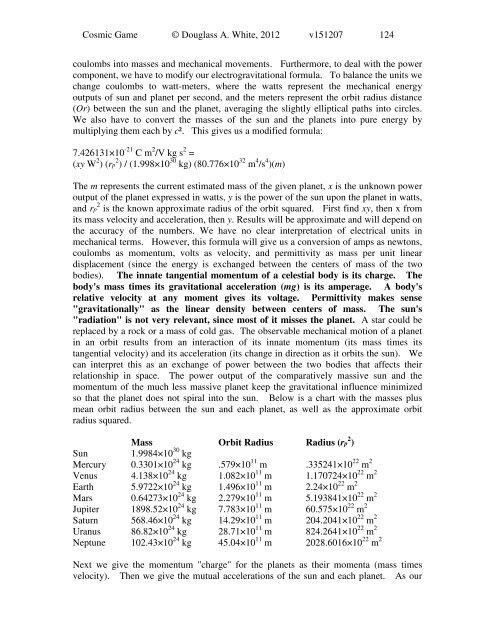You also want an ePaper? Increase the reach of your titles
YUMPU automatically turns print PDFs into web optimized ePapers that Google loves.
<strong>Cosmic</strong> <strong>Game</strong> © Douglass A. White, 2012 v151207 124<br />
coulombs into masses and mechanical movements. Furthermore, to deal with the power<br />
<strong>com</strong>ponent, we have to modify our electrogravitational formula. To balance the units we<br />
change coulombs to watt-meters, where the watts represent the mechanical energy<br />
outputs of sun and planet per second, and the meters represent the orbit radius distance<br />
(Or) between the sun and the planet, averaging the slightly elliptical paths into circles.<br />
We also have to convert the masses of the sun and the planets into pure energy by<br />
multiplying them each by c². This gives us a modified formula:<br />
7.426131×10 -21 C m 2 /V kg s 2 =<br />
(xy W 2 ) (rp 2 ) / (1.998×10 30 kg) (80.776×10 32 m 4 /s 4 )(m)<br />
<strong>The</strong> m represents the current estimated mass of the given planet, x is the unknown power<br />
output of the planet expressed in watts, y is the power of the sun upon the planet in watts,<br />
and rp 2 is the known approximate radius of the orbit squared. First find xy, then x from<br />
its mass velocity and acceleration, then y. Results will be approximate and will depend on<br />
the accuracy of the numbers. We have no clear interpretation of electrical units in<br />
mechanical terms. However, this formula will give us a conversion of amps as newtons,<br />
coulombs as momentum, volts as velocity, and permittivity as mass per unit linear<br />
displacement (since the energy is exchanged between the centers of mass of the two<br />
bodies). <strong>The</strong> innate tangential momentum of a celestial body is its charge. <strong>The</strong><br />
body's mass times its gravitational acceleration (mg) is its amperage. A body's<br />
relative velocity at any moment gives its voltage. Permittivity makes sense<br />
"gravitationally" as the linear density between centers of mass. <strong>The</strong> sun's<br />
"radiation" is not very relevant, since most of it misses the planet. A star could be<br />
replaced by a rock or a mass of cold gas. <strong>The</strong> observable mechanical motion of a planet<br />
in an orbit results from an interaction of its innate momentum (its mass times its<br />
tangential velocity) and its acceleration (its change in direction as it orbits the sun). We<br />
can interpret this as an exchange of power between the two bodies that affects their<br />
relationship in space. <strong>The</strong> power output of the <strong>com</strong>paratively massive sun and the<br />
momentum of the much less massive planet keep the gravitational influence minimized<br />
so that the planet does not spiral into the sun. Below is a chart with the masses plus<br />
mean orbit radius between the sun and each planet, as well as the approximate orbit<br />
radius squared.<br />
Mass Orbit Radius Radius (rp 2 )<br />
Sun 1.9984×10 30 kg<br />
Mercury 0.3301×10 24 kg .579×10 11 m .335241×10 22 m 2<br />
Venus 4.138×10 24 kg 1.082×10 11 m 1.170724×10 22 m 2<br />
Earth 5.9722×10 24 kg 1.496×10 11 m 2.24×10 22 m 2<br />
Mars 0.64273×10 24 kg 2.279×10 11 m 5.193841×10 22 m 2<br />
Jupiter 1898.52×10 24 kg 7.783×10 11 m 60.575×10 22 m 2<br />
Saturn 568.46×10 24 kg 14.29×10 11 m 204.2041×10 22 m 2<br />
Uranus 86.82×10 24 kg 28.71×10 11 m 824.2641×10 22 m 2<br />
Neptune 102.43×10 24 kg 45.04×10 11 m 2028.6016×10 22 m 2<br />
Next we give the momentum "charge" for the planets as their momenta (mass times<br />
velocity). <strong>The</strong>n we give the mutual accelerations of the sun and each planet. As our





